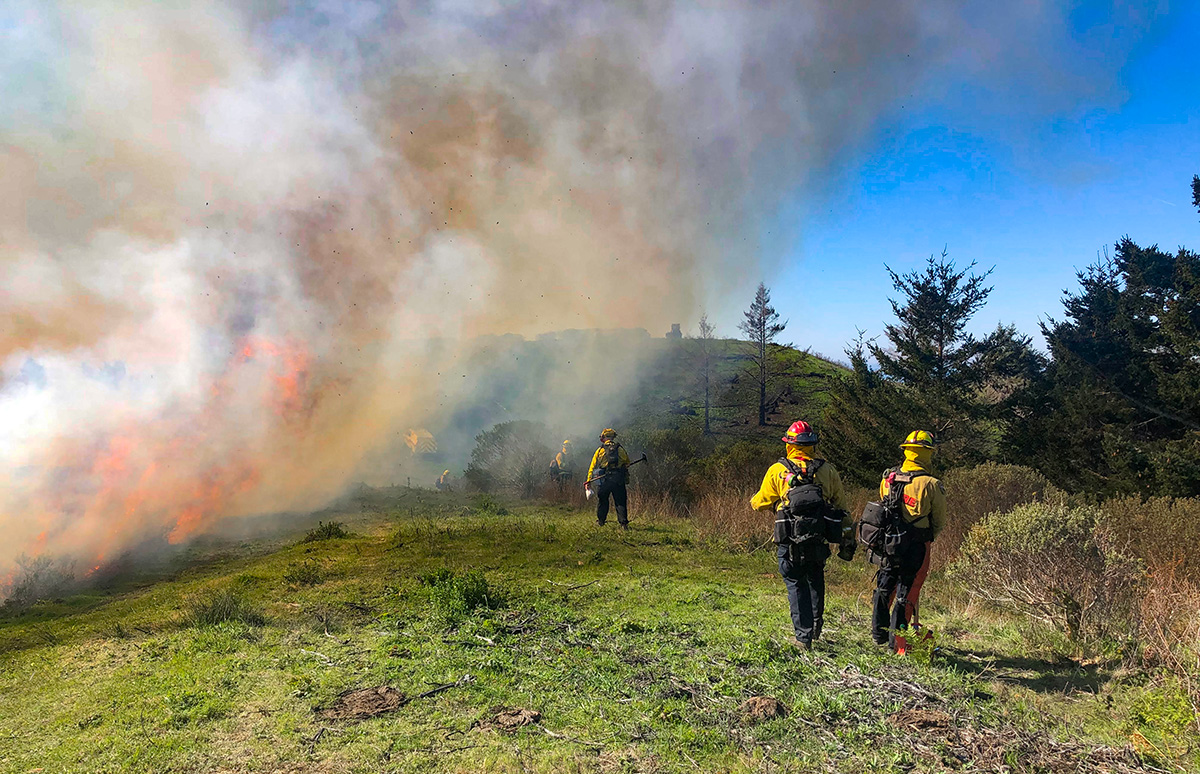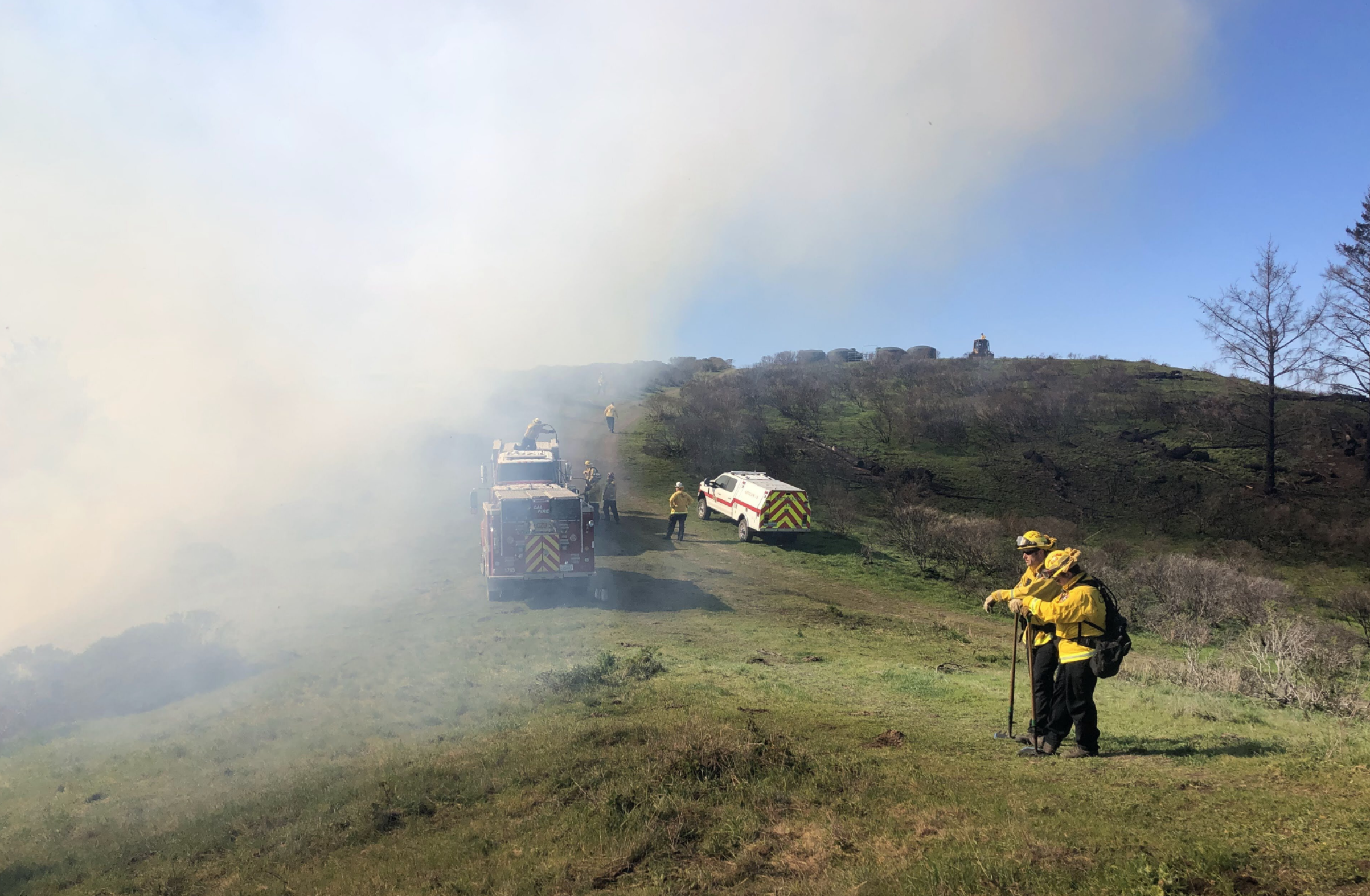Changes in California’s climate are increasing autumn wildfire risk, which threatens human and natural communities alike with catastrophic wildfire events.
Fire Management and Prescribed Burns at TomKat Ranch

PRESCRIBED BURNS FOR PUBLIC SAFETY AND ECOLOGICAL GOALS
Changes in California’s climate are increasing autumn wildfire risk (Goss et al 2020), which threatens human and natural communities alike with catastrophic wildfire events. Using prescribed fire to reduce wildfire risk may be an excellent climate-adaptation strategy with multiple additional benefits. To this end, TomKat Ranch is working to implement a prescribed burn and fuel break program in cooperation with the California Department of Forestry and Fire Protection (CalFire) San Mateo/Santa Cruz Unit. We are excited about the opportunity for prescribed burns in San Mateo County to reduce the risk (both in number and severity) of catastrophic wildfires in our county, as well as provide ecological benefits for the ranch’s fire-dependent Mediterranean ecosystems.
Nearly all of California’s diverse ecosystems are dependent on or adapted to wildfire, and native Californians often used fire as a management tool. In fact, indigenous people in nearby Quiroste Valley used frequent, low severity fires to maintain open coastal prairie grasslands for hundreds, perhaps thousands, of years (Lightfoot et al 2013, Evett and Cutthell 2013). Modern fire suppression has led to woody species encroachment into coastal grasslands, as well as overstocked forests that are less resilient to diseases, insects, and catastrophic wildfire events.
Within this context, prescribed burns and fuel breaks have multiple potential benefits, including reducing catastrophic wildfire risk (and the associated large scale carbon loss) as they help address fuels build up, improve habitat for wildlife and plants that depend on fire disturbance (including fire-dependent rare/endangered species), and provide non-chemical alternatives for managing invasive or noxious weeds. Additionally, prescribed burning can also improve the health of grasslands for livestock and wildlife by improving near-term nutrient cycling and reducing woody species encroachment which creates more open, contiguous grassland habitat that benefits grassland obligate species such as Grasshopper Sparrows, badgers, and Burrowing Owls.
Both TomKat Ranch and CalFire understand the benefits of prescribed fire and natural disturbance for the ranch’s ecosystem, our rural community, and for California, especially during times of increasing drought and warming temperatures. While there are many documented benefits of prescribed fire, variability in results can also exist and – as with most management tools, we are interested in using this opportunity to track and better understand how prescribed burns can complement our regenerative grazing program to achieve strategic goals set forth by the ranch. These goals include:
SAFETY GOALS
- Reduce fuel loads that might otherwise lead to catastrophic wildfire
- Increase safety for human communities
- Protect existing infrastructure
ECOLOGICAL GOALS
- Minimize woody species (i.e. conifer, coastal scrub) encroachment of grasslands
- Promote native perennial grass abundance
- Promote native plant diversity, especially fire-dependent wildflowers
- Improve forage quality
- Maintain and improve habitat for grassland obligates (grassland breeding birds, Burrowing Owls, badgers, etc.)
- Reduce the risk of large carbon losses related to catastrophic wildfire

MONITORING PROGRESS
In service of TomKat Ranch’s mission to be a living, learning laboratory, we will monitor progress towards our ecological goals over time, and will also consider monitoring other aspects of the system, including soil communities, which can be negatively affected by prescribed fire under some circumstances. This will allow us to determine how well the prescribed burns are helping us to achieve our goals and whether any trade-offs exist. We will share all that we are learning with other ranchers and land stewards to help inform the adoption of this important practice more broadly.
ENSURING A SAFE AND EFFECTIVE BURN
Ensuring a safe and effective burn is a top priority for our team, and CalFire leads with excellence in this space. We will work with CalFire to conduct successful prescribed burns by carefully selecting sites, creating fuel breaks and thinning, and implementing the burns during the appropriate time of year.
Site selection. CalFire will conduct all prescribed burning and line preparations required for a safe and successful prescribed burn. TomKat Ranch and the ranch’s on-site partners Point Blue Conservation Science will work with CalFire to identify optimal locations for prescribed burns based on resource concerns and site-specific goals, informed by Point Blue’s ecological monitoring data and the ranch’s regenerative grazing plans over the last 8 years. We will generate a plan that outlines the goals for each site selected and that describes how we will track progress over time.
Fuel breaks and thinning. Prior to burning, constructed containment lines are made, traditionally with heavy equipment or by hand. Pre-treatments such as crushing or masticating brush, and limbing and/or falling dead trees are also conducted to reduce fuels to a manageable level prior to burning. Shaded fuel breaks are commonly used, which are areas along ingress and egress routes to a property where understory vegetation is thinned or removed but the majority of larger, more fire tolerant tree species are left intact.
Fuel breaks using heavy equipment can be destructive, and may actually hinder our ability to achieve our ecological goals. We therefore plan to trial a number of new approaches to making and managing fuel breaks, which, if successful, will help to minimize this tradeoff and potentially increase the value and adoption of prescribed fire in regenerative operations. Specifically, we will:
- Create shaded fuel breaks and utilize livestock grazing where possible (cattle on grasslands, goats on the brush).
- Attempt to eliminate or at least minimize bare ground (scraped) fuel breaks, even if properly shaped, to avoid creating future erosion zones. The process of creating bare soil fuel breaks destroys soil microbiology, disturbs and releases soil carbon, promotes erosion that can enter waterways and disturb aquatic ecosystems, and creates conditions for invasive weeds to flourish.
- Apply a combination of regenerative practices, including bale grazing, seeding, and mulching, to cover any bare soil areas that are exposed.
Timing. We will work with CalFire to implement the prescribed burns at a time of year that minimizes risks to human safety and wildlife populations (e.g. breeding amphibians and reptiles, breeding birds).

SECURING PERMITS AND MAINTAINING COMPLIANCE
CalFire will write a Vegetation Management Program Contract (VMP) and prepare a California Environmental Quality Act (CEQA) compliance document to be approved by CalFire through the state clearinghouse. CalFire will also obtain necessary permits and conduct all fire control actions for this program. For this project, TomKat Ranch will enter into a contract with CalFire, known as a VMP. As CalFire understands that they can never absolutely eliminate all risk associated with a fire, a VMP agreement protects landowners from any legal responsibility. There will be no exchange of money for the projects.
CITATIONS
Goss, M., Swain, D., Abatzoglou, J.T., Sarhadi, A., Kolden, C., Williams, A.P., Diffenbaugh, N.S. (2020). Climate change is increasing the risk of extreme autumn wildfire conditions across California. Environmental Research Letters, 2020; DOI: 10.1088/1748-9326/ab83a7
Lightfoot, K. G., et al. (2013). Anthropogenic burning on the Central California coast in Late Holocene and Early historical times: findings, implications, and future directions. California Archaeology 5.2: 371-390.
Evett, R. R. and Cuthrell, R.Q. (2013). Phytolith evidence for a grass-dominated prairie landscape at Quiroste Valley on the Central Coast of California. California Archaeology 5.2: 319-335.